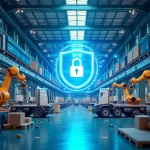
Cosmikal at Web Summit Qatar 2025: Advanced Cybersecurity for Critical Infrastructure
6 de March de 2025
Cybersecurity in the Supply Chain
13 de March de 2025Operational Technology (OT) systems are the heart of energy infrastructures. They manage critical processes in oil platforms, refineries, power grids, hydroelectric plants, gas facilities, and more. However, the increasing interconnectivity between OT and IT has made these environments an attractive target for cybercriminals. The lack of adequate security measures in these systems can lead to operational disruptions, sabotage, and devastating economic consequences.
This article outlines the risks and strategies to protect connections to OT devices in the energy sector.
Main threats in the energy OT environment
- Targeted ransomware:
- Devices such as PLCs (Programmable Logic Controllers), RTUs (Remote Terminal Units), and SCADA systems can be compromised, blocking access and paralyzing entire plants. A cyberattack similar to the Colonial Pipeline incident could disrupt energy distribution across entire regions.
- Advanced persistent threats (APT)
- Specialized groups can exploit vulnerabilities in turbine monitoring systems, pumping stations, and electrical transformers, gaining persistent access for espionage or industrial sabotage. The Triton attack attempted to manipulate safety systems in petrochemical plants, demonstrating the potential of such attacks to compromise physical security.
- SCADA and IIoT attacks
- Exploiting vulnerabilities in SCADA systems and IIoT devices used for monitoring power grids and pipelines could cause massive failures. Cyberattacks could target pressure sensors in gas pipelines or induce overloads in substations, leading to severe operational disruptions.
- Lateral movement from IT to OT
- Unauthorized access to the corporate network can allow attackers to infiltrate DCS (Distributed Control Systems), network protection systems, and substation controllers. This type of intrusion could disable automatic protections and cause widespread blackouts.
- Manipulation of industrial protocols
- Protocols such as Modbus, DNP3, and IEC 60870-5-104 lack strong encryption and authentication mechanisms. This makes them vulnerable to interception and command modification attacks, potentially leading to gas valve malfunctions, pumping station failures, or even catastrophic events such as overflows, leaks, or fires.
Challenges in protecting connections to OT devices
Connections to OT devices in the energy sector face multiple challenges. Legacy systems, such as RTUs in hydroelectric plants and PLCs in refineries, were not designed with modern security in mind. Insecure remote access methods, such as traditional VPNs and unprotected RDP, allow leaks. Unencrypted industrial protocols, like Modbus and DNP3, facilitate interception attacks. Additionally, lateral movement from IT to OT can compromise transformer stations and wind turbines. Ensuring security without affecting operations is crucial in an increasingly interconnected environment.
- Legacy systems:
- Many energy plants use OT devices that are decades old, such as RTUs in hydroelectric dams and PLCs in refineries, which were not designed with modern security measures and cannot be easily updated. Securing remote connections to these devices should be a top priority.
- Insecure remote access:
- Engineers and technicians often access critical equipment via traditional VPN connections or unprotected RDP, allowing attackers to steal credentials and infiltrate control systems for turbines or gas compressors.
- Impact of latency:
- Many cybersecurity solutions introduce latency in real-time communications, which can affect the operation of sensors in electrical transformer stations and actuators in wind generators.
Strategies to Secure Connections to OT Devices
- Shielded Remote Desktop with Privileged Access Management (PAM)
- Secure, completely isolated working environment.
- Implementation of controlled and audited access to PLCs, RTUs, and SCADA systems.
- Reduced risk of credential theft through multi-factor authentication and Encrypted Vault.
- Logging of all sessions to detect manipulation attempts on critical devices.
- Secure Virtual Desktop Infrastructure (VDI)
- Creation of virtual desktops for remote access without exposing OT networks.
- Segmentation that prevents direct access to OT devices like control stations in refineries or electrical substations.
- Zero Trust and Network Segmentation
- Application of Zero Trust principles to restrict unauthorized access, such as to turbine monitoring networks and nuclear facilities.
- Implementation of OT-specific application firewalls.
- Protection of Industrial Protocols
- Encryption implementation in protocols like Modbus and IEC 61850.
- Use of security gateways to translate and filter commands before reaching valve controllers and pipeline pumps.
- Advanced Monitoring with SIEM and IDS/IPS
- Real-time event analysis in electrical substations and refineries.
- Integration with AI to detect suspicious behaviors, for example, in hydroelectric generator controllers.
Regulations and Security Standards in Energy OT
- NIS2: Requires strengthened cybersecurity measures for critical infrastructures.
- IEC 62443: Provides a specific security framework for industrial environments.
- NERC CIP: Regulates the protection of electrical systems against cyber threats.
Compliance with these regulations is facilitated by solutions like Endurance, the Shielded Remote Desktop that integrates PAM and VDI, ensuring secure and monitored access to OT environments.
Security in energy OT is not optional: it is a strategic necessity. The adoption of advanced solutions like our Shielded Work Desktop with PAM, VDI, and Zero Trust segmentation not only mitigates risks but also strengthens operational resilience.
The protection of critical infrastructures is key to global energy stability, and companies in the sector must prioritize the security of their OT connections in an environment of constantly evolving threats.
Endurance also incorporates an Encrypted Vault that securely stores and manages access credentials, drastically reducing the chances of theft or misuse. This feature adds an extra layer of protection, ensuring that even if an attacker compromises a system, they cannot access critical credentials. This makes Endurance one of the most comprehensive and robust solutions for protecting OT environments in the energy sector.





